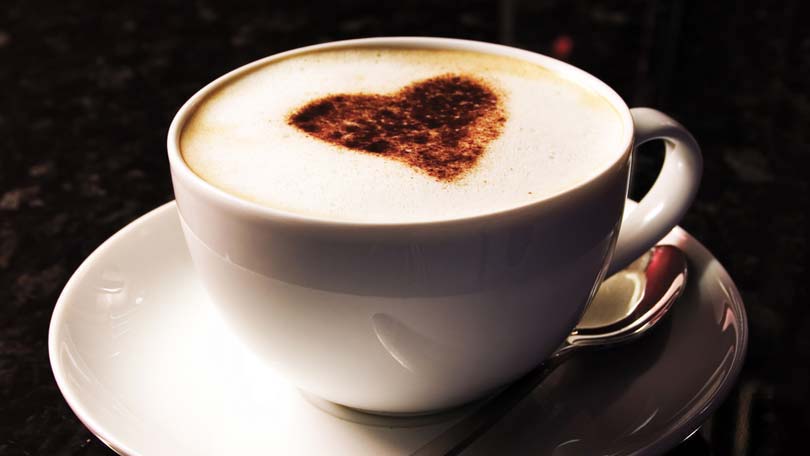
In Italy, ordering a latte gets you a tall glass of milk. In North America however, where people are apparently too rushed to ask for a ‘caffè latte’, a latte order will get you a steaming mug (or more likely a Styrofoam to-go cup) of espresso and milk. A drink that will perk up the overworked and overtired, the latte has become a staple for many people who need that extra boost of energy each morning.
What is now recognized as the American latte began in Italy as the caffè latte, literally meaning coffee and milk. A drink that remained entirely Italian until the 1980s, the caffè latte began its ascent into popular culture during the coffee craze that originated in Seattle and then spread throughout the rest of the United States. Much of the latte’s success has to do with Starbucks, the coffee giant that helped introduce many of the coffee drinks that we know and love today.
Presently, a latte drink is prepared as one-third espresso and almost two-thirds milk, with a slight bit of foam on top. Espresso is a concentrated coffee drink made by forcing hot water through coffee beans that have been ground to a fine powder. The espresso has more caffeine, a more intense flavor, and thicker consistency than coffee. The intensity of espresso makes it very fit for mixing with milk because although a latte may only have one part espresso versus two parts milk, the coffee flavor remains strong, as do its energizing effects.
To add confusion, the latte is one of many espresso and milk drinks; others such as the cappuccino and flat white are very close relatives. If you happen to accidentally order a cappuccino instead of a latte, or the other way around, have no fear the drinks are quite similar. The difference between these espresso drinks has to do with the proportion of milk to the proportion of froth that tops the espresso base. Froth (or foam) comes from the steaming of milk, where hot air is incorporated into the milk via a steam wand. A cappuccino will have approximately one-third foam, one-third steamed milk, and one-third espresso. Because a cappuccino has more foam and less milk than a latte, it will have a stronger espresso taste. A flat white is at the other end of the spectrum, where absolutely no foam is added to the drink, making it one-third espresso and the rest milk. Usually, a coffeehouse will have both the latte and the cappuccino on the menu; rarely will they have the flat white.
While ordering a latte should be relatively simple (‘I would like a latte please.’), the process has become complicated by the numerous options available for the content of the latte. Because people like options, most coffee houses carry different milks and flavorings to suit an individual’s need. For example, a ‘skinny’ latte would be a latte made with non-fat milk. If unspecified, the establishment will go with what tastes the best (whole milk), so be sure to make clear the type of milk you desire when ordering. Other options are soy milk or two-percent. Also, to make each drink sound as large as possible, coffeehouses offer tall, grande, and venti drinks instead of the traditional large versus small. Most often, a tall drink (equivalent to a small) is 12 ounces, a grande (equivalent to a medium) 16 ounces, and a venti (equivalent to large) 20 ounces. Now, while some will offer specifically flavored lattes on the menu, be aware that you can have any one flavor, or combination of flavors, added to your latte. One popular flavor is vanilla, so you would order a ‘tall vanilla latte.’ If you were especially sleepy, you could even order more espresso in your drink. A tall usually has one shot glass full of espresso, a grande has two, and venti three. You would say ‘tall double shot vanilla latte please.’ As a guideline, follow this format:
- size (tall)
- milk request* (skim, skinny, non-fat, two-percent)
- additional espresso shots request OR decaf request* (double shot, triple shot, half-caf)
- flavor request (vanilla, hazelnut, caramel)
- latte
- whip cream specifications* (no-whip)
*-omit if N/A
Initially, ordering a latte will seem more convoluted than it really is, but you will soon learn exactly how you like your latte, and will become accustomed to asking for it that way every time.
Makers of lattes, known as baristas, will even sometimes add a mark of artistic expression to the top of a latte by manipulating the froth into a design, known as latte art. More common in smaller, intimate coffee shops, latte art is an added touch that is thought to be the mark of a gracefully prepared beverage.
A mixture of espresso and milk, the latte is a treasure from Italy that has found a special place in the lives of many people, as can be gathered from the high prices paid for these specialty drinks. At over three dollars a pop, the latte, though delicious, can become a burden to the budget, so be careful to enjoy them in moderation!
